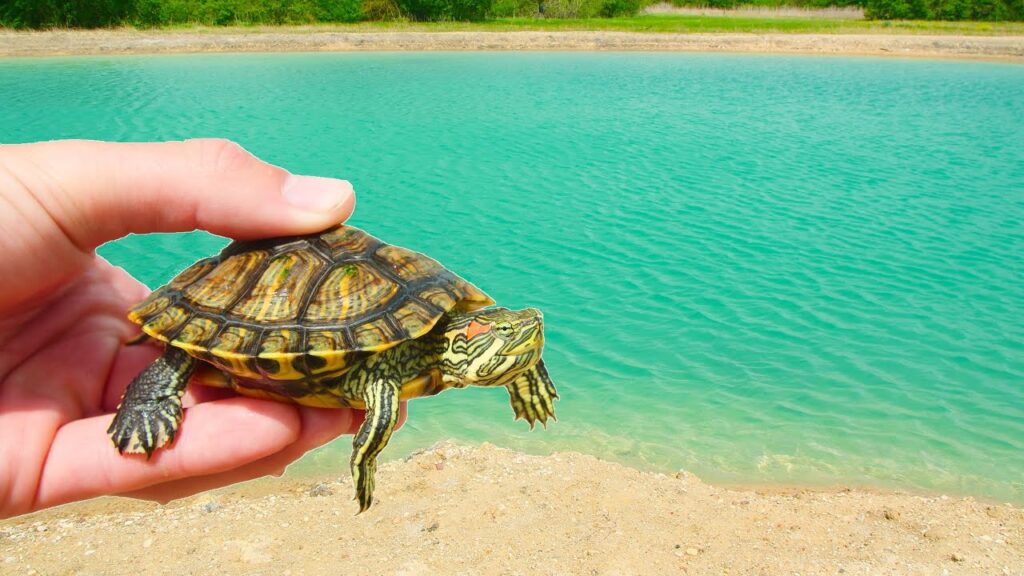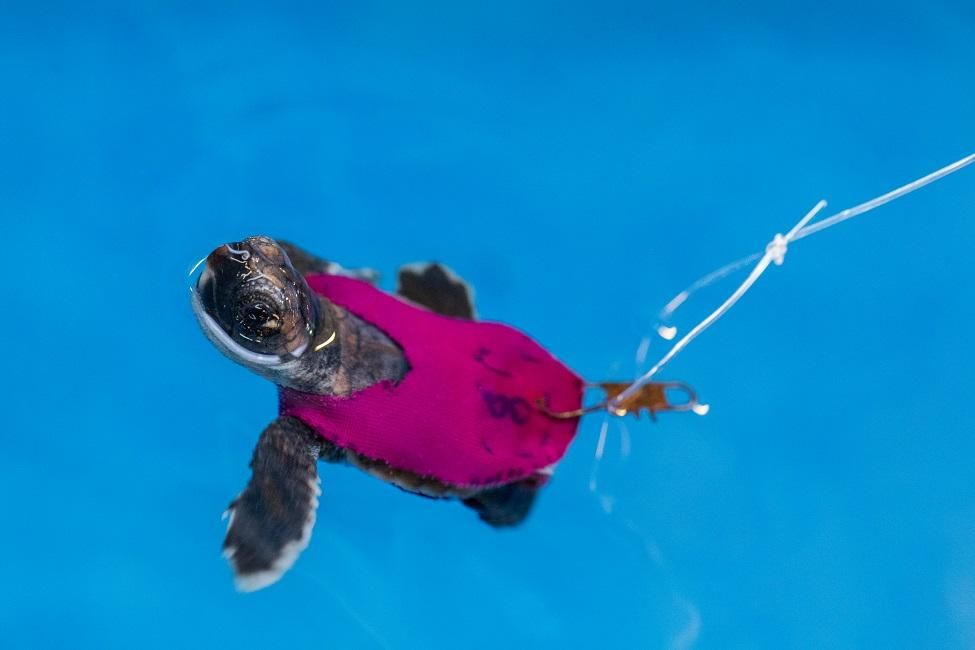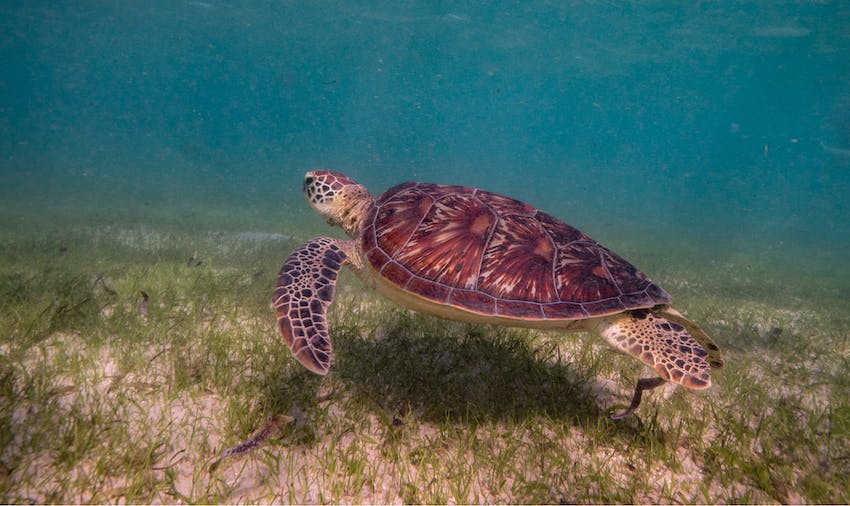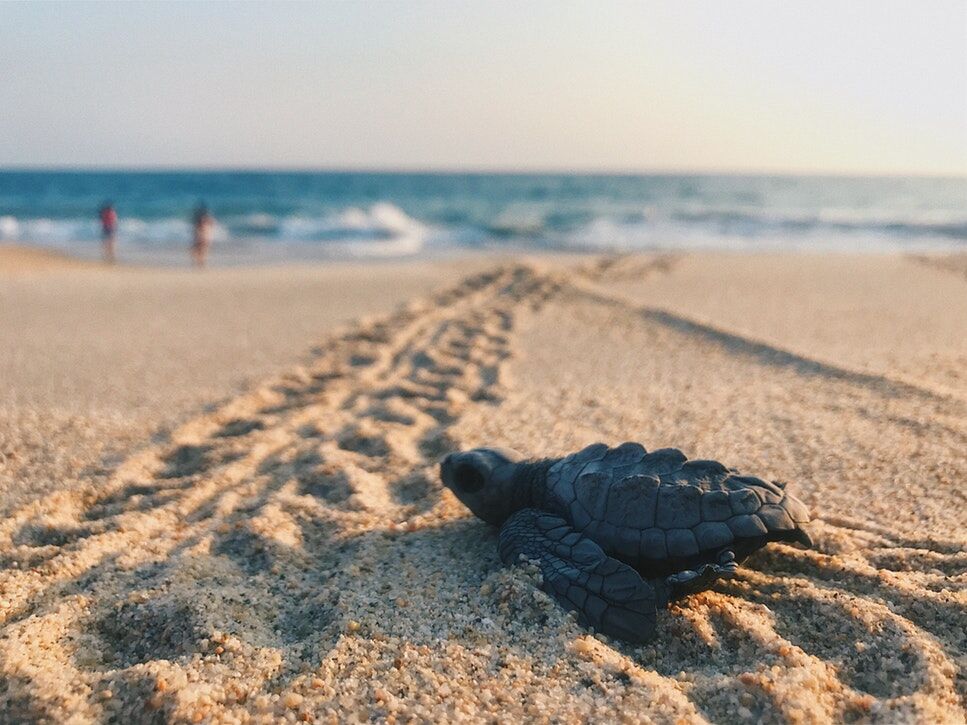Get ready to witness a remarkable journey as we take you on a guided tour of the mesmerizing process of introducing baby turtles to the great outdoors. In this article, we will uncover the secrets of their supervised exploration, as these tiny, resilient creatures embark on their thrilling mission of discovering the vast wonders of their natural habitat. Brace yourself for an adventure of a lifetime, as we unravel the intricacies of nurturing and guiding these young hatchlings towards a future filled with resilience and boundless possibilities.
With expert guidance from trained professionals, these baby turtles are carefully introduced to the vast and intricate world beyond their protective shells. This article will delve into the meticulous planning, precise techniques, and dedicated care that go into ensuring the safety and well-being of these remarkable creatures. From the art of selecting the ideal environmental conditions to the delicate process of acclimatization, we will explore the various stages that contribute to their successful adaptation. Prepare to be amazed as we witness the transformation of these once-vulnerable hatchlings into strong and awe-inspiring turtles, ready to conquer the challenges that await them in the untamed wilderness. Join us on this enthralling exposé as we accompany these bold and determined creatures on their remarkable journey towards freedom and self-discovery.

Preparing the Outdoor Environment
Choosing a suitable outdoor area
When preparing to introduce baby turtles to the outdoors, it is important to carefully select a suitable area for their exploration. Look for a space that provides a balance of sunlight and shade, as well as sufficient room for the turtles to move around freely. Additionally, take into consideration the climate and weather conditions in your area to ensure it is conducive to their well-being.
Checking for potential hazards
Before allowing baby turtles to explore the outdoors, it is crucial to conduct a thorough inspection of the area for any potential hazards. Remove any sharp objects, toxic plants, or other substances that could pose a danger to the turtles. Be mindful of any small openings or gaps that could allow them to escape or be exposed to predators.
Creating a secure enclosure
To ensure the safety of the baby turtles, it is essential to create a secure enclosure in the outdoor area. Use materials such as wire mesh or fencing that are sturdy enough to prevent any potential predators from entering the enclosure. Make sure that the enclosure is buried underground to discourage digging from predators or the turtles themselves.
Providing adequate shelter and shade
Baby turtles, just like their adult counterparts, need shelter and shade to protect themselves from extreme temperatures and sun exposure. Provide a variety of hiding spots, such as rocks or logs, where the turtles can retreat when necessary. It is also important to provide artificial or natural shading options, such as plants or overhead covers, to ensure they can regulate their body temperature effectively.
Ensuring proper water source
Water is an essential element for baby turtles, so ensuring they have access to a suitable water source is vital. Provide shallow dishes or containers filled with clean water that is regularly replenished. The size of the water source should be appropriate for the size of the turtles, allowing them to safely enter and exit. It is important to monitor the water quality regularly to prevent any potential health issues.
Acclimating Baby Turtles to Outdoor Conditions
Gradual transition process
When introducing baby turtles to the outdoor environment, it is crucial to facilitate a gradual transition process. Start by allowing them short periods of supervised exposure to the outdoors and gradually increase the duration over time. This gradual acclimation helps them adjust to the new environment and minimizes stress.
Maintaining suitable temperature and humidity levels
Baby turtles require specific temperature and humidity levels to thrive. Monitor and maintain these levels within the outdoor enclosure to ensure their well-being. Use thermometers and hygrometers to accurately measure and regulate the conditions. Providing additional heat sources or misting systems may be necessary to maintain optimal conditions.
Monitoring sunlight exposure
While natural sunlight is beneficial for baby turtles, it is important to monitor and control their exposure. Direct sunlight for extended periods can lead to overheating and dehydration. Ensure that the outdoor area has both sunny and shady spots, allowing the turtles to regulate their exposure. Always supervise their time outdoors and provide artificial shade options for them to retreat to.
Handling potential predators
The outdoor environment exposes baby turtles to potential predators, such as birds or small mammals. It is essential to take measures to protect them from these threats. Creating a secure enclosure, as mentioned earlier, is the primary defense against predators. You may also consider using deterrents like motion-activated sprinklers or nets to further discourage predator access.
Ensuring access to water
Water is vital for baby turtles’ survival, and providing them with easy access to water is crucial. Ensure they can easily enter and exit the water source within their outdoor enclosure. Baby turtles should be supervised while in the water to prevent any accidents or drowning. Additionally, regularly clean and replace the water to maintain its cleanliness and prevent the growth of harmful bacteria.
Supervising Baby Turtles during Outdoor Exploration
Setting up a designated exploration area
When baby turtles are ready for outdoor exploration, it is important to establish a designated area for their activities. This area should be safe and secure, allowing them to roam freely without the risk of escaping or encountering predators. Make sure the enclosure is large enough to provide ample space for movement and natural behaviors.
Appropriate exploration time
While outdoor exploration is beneficial for baby turtles, it is essential to limit their time outside to avoid excessive stress or exposure to potential hazards. Start with short periods of exploration and gradually increase the duration as they become more comfortable. Monitor their behavior and adjust the exploration time accordingly.
Monitoring behavior and interaction
Supervision is essential during baby turtles’ outdoor exploration to ensure their safety and well-being. Observe their behavior, interaction with the environment, and any potential signs of distress or discomfort. This close monitoring allows you to intervene promptly if necessary and make adjustments to their environment or routine as needed.
Protective measures during exploration
While baby turtles are exploring, there are additional measures you can take to protect them further. Placing barriers or screens around the designated area can prevent escape attempts and discourage intrusions from other animals. Always be vigilant and remove any potential hazards that they may encounter, such as sharp objects or toxic plants.
Signs of distress or discomfort
As you supervise baby turtles during their outdoor exploration, be attentive to any signs of distress or discomfort. These may include excessive hiding, lethargy, loss of appetite, or abnormal behavior. If you notice any of these signs, it is crucial to address them promptly to ensure the well-being of the turtles. Consult a veterinarian if necessary.
Encouraging Natural Behaviors and Foraging
Providing a varied diet
To encourage natural behaviors and healthy growth, it is important to provide baby turtles with a varied and balanced diet. Research the specific dietary needs of their species and offer a combination of commercial turtle food, fresh vegetables, and live or frozen prey such as insects or small fish. Consult a reptile veterinarian or an expert for guidance on appropriate feeding and nutritional requirements.
Creating natural foraging opportunities
In their outdoor environment, promote natural foraging behaviors by creating opportunities for the baby turtles to search for food. Scatter food items in hidden or slightly buried areas, encouraging them to explore and use their natural instincts to find their meals. This not only stimulates their foraging behaviors but also provides mental and physical enrichment.
Promoting exercise and physical activity
Just like any other living creature, baby turtles need physical exercise to promote healthy growth and development. Encourage exercise by providing a spacious, safe, and stimulating outdoor area. Ensure they can freely move around, climb on rocks or logs, and navigate different terrain. Observe their behaviors and interactions to ensure they are getting enough physical activity.
Simulating natural habitat
To encourage natural behaviors, try to replicate elements of their natural habitat within the outdoor enclosure. Use non-toxic plants, rocks, and other natural materials to create an environment that resembles their natural surroundings. This stimulates their natural instincts and allows them to exhibit natural behaviors, contributing to their overall well-being.
Stimulating mental and sensory engagement
To keep baby turtles mentally stimulated, provide various enrichment opportunities in their outdoor enclosure. This can include objects to climb on, explore, or investigate. For example, you can place non-toxic toys, tunnels, or shells for them to interact with. Engaging their senses through different textures, scents, and visual stimuli can be highly beneficial.

Maintaining Hygiene and Health
Regular cleaning of outdoor enclosure
To maintain a healthy environment for baby turtles, regular cleaning of the outdoor enclosure is essential. Remove any feces, uneaten food, or debris daily, and thoroughly clean the enclosure at regular intervals. Use reptile-safe disinfectants to ensure cleanliness and prevent the buildup of harmful bacteria or parasites.
Preventing the spread of diseases
In an outdoor environment, there is an increased risk of exposure to potential diseases or parasites. Minimize this risk by practicing proper hygiene measures. Wash your hands thoroughly before and after handling the baby turtles. Avoid introducing potentially contaminated items or animals into their enclosure. Regularly monitor their health and consult a veterinarian if any signs of illness arise.
Monitoring for signs of illness or injury
Regularly monitor baby turtles for any signs of illness or injury. Look for changes in behavior, appetite, or physical appearance that may indicate a health issue. Monitor for signs of shell rot, respiratory problems, eye infections, or other common health concerns. Promptly address any concerns and seek veterinary care as necessary.
Timely veterinary check-ups
Regular veterinary check-ups are crucial for the overall health and well-being of baby turtles. Consult with a reptile veterinarian who can provide guidance on proper care, nutrition, and address any health concerns. Regular check-ups can help detect and prevent potential health problems and ensure that the turtles are receiving appropriate care.
Proper waste management
Baby turtles produce waste that needs to be managed properly to maintain hygiene and prevent contamination. Ensure that their outdoor enclosure has a dedicated waste management system. Regularly remove and dispose of their waste in an appropriate manner. Avoid allowing waste to accumulate as it can lead to unsanitary conditions and potential health risks.
Introducing Baby Turtles to Other Animals
Supervised interaction with other turtles
If you have multiple turtles, it may be beneficial for them to interact with one another under supervision. However, not all turtles are compatible, and territorial disputes can occur. Introduce them gradually, keeping a close eye on their interactions. If aggression or stress is observed, separate them immediately to prevent potential harm.
Gradual introduction to compatible species
If introducing baby turtles to other animals, such as fish or reptiles, it is important to proceed with caution. Research the specific compatibility of different species and introduce them gradually. Observe their interactions closely and be prepared to separate them if any signs of aggression or stress arise.
Monitoring for aggressive behavior
During interactions with other turtles or animals, it is crucial to monitor for any signs of aggressive behavior. These may include biting, hissing, or prolonged chasing. Aggressive behavior can lead to injuries or stress for the baby turtles. If aggression occurs, it is essential to separate the individuals involved.
Ensuring adequate space and resources
When introducing baby turtles to other animals, ensure that they have adequate space and resources to thrive. Avoid overcrowding or situations where competition for food or shelter becomes an issue. Each species should have its own designated areas and sufficient resources like food, water, and hiding spots to minimize conflicts.
Avoiding stress and overcrowding
Stress and overcrowding can have detrimental effects on the health and well-being of baby turtles. Avoid introducing them to situations where they may feel overwhelmed or overcrowded. Monitor their behavior closely and create an environment that allows them to feel safe and secure.

The Importance of Environmental Enrichment
Providing a stimulating and enriching environment
Environmental enrichment plays a vital role in keeping baby turtles happy and healthy. Provide a stimulating and enriching environment that offers opportunities for exploration and natural behaviors. Incorporate various elements like rocks, logs, and plants to create an engaging and diverse habitat.
Using natural materials and objects
Utilizing natural materials and objects in the baby turtles’ outdoor enclosure adds to the authenticity of their environment. Use non-toxic plants, branches, stones, or shells to create a more natural setting. This allows the turtles to interact with their surroundings and engage in natural behaviors.
Implementing hiding spots and resting areas
Offering hiding spots and resting areas is essential for baby turtles’ mental and physical health. Use rocks, logs, or artificial caves for the turtles to retreat to when they need privacy or a break from stimulation. These resting areas provide a sense of security and contribute to their overall well-being.
Rotating toys and enrichment items
To prevent boredom, periodically rotate toys and enrichment items within the outdoor enclosure. This keeps the environment fresh and engaging for the baby turtles. Consider introducing new elements like puzzles, floating toys, or objects that allow them to interact and explore.
Avoiding excessive captivity stress
Excessive stress can negatively impact baby turtles’ health and well-being. Avoid subjecting them to excessive stress by providing an enriching and appropriate outdoor environment. By ensuring their enclosure mimics their natural habitat and incorporating stimulating elements, you can minimize captivity stress and promote a comfortable and fulfilling life for the turtles.
Recognizing the Signs of Maturity and Independence
Age and size as indicators
As baby turtles grow, their age and size can serve as indicators of their level of maturity and independence. Research the specific species and consult with experts to understand the typical growth patterns and milestones. Take these factors into account when determining if the turtles are ready for potential release or permanent outdoor habitation.
Behavioral changes and preferences
As baby turtles mature, they may exhibit behavioral changes and preferences. They may become more independent and display natural instincts and behaviors seen in adult turtles of their species. They may also show preferences for specific foods, habitats, or interactions. Observe and learn about these changes to provide appropriate care and cater to their evolving needs.
Decreasing dependency on human intervention
As baby turtles grow, they will gradually become less dependent on human intervention. They may require less frequent monitoring, handling, or assistance with feeding. This transition indicates their increasing independence and ability to thrive in their natural environment.
Preparing for potential release or permanent outdoor habitation
Depending on factors such as the species, local regulations, and the turtles’ readiness, you may need to prepare for potential release or permanent outdoor habitation. Research the specific requirements and considerations for releasing baby turtles into the wild or transitioning them to a more permanent outdoor enclosure. Follow appropriate protocols to ensure their successful transition.
Adjusting care and environmental conditions
As baby turtles mature, adjustments may be necessary in their care and environmental conditions. Their dietary needs, enclosure size, temperature requirements, and interactions may change. Stay informed and make the necessary adjustments to provide the best care and habitat for the turtles according to their developmental stages.

Responsible Ownership and Legal Considerations
Understanding local regulations and permits
Before and during the process of introducing baby turtles to outdoor environments, it is essential to understand and comply with local regulations and permits. Different regions or countries may have specific laws governing the ownership, care, release, or permanent habitation of turtles. Research and abide by these regulations to ensure responsible ownership.
Educating yourself about species-specific needs
Each turtle species has unique needs and requirements. Educate yourself about the specific needs of the baby turtles you are caring for, including their diet, habitat, temperature requirements, and potential health concerns. This knowledge allows you to provide appropriate care and ensure their well-being.
Proper sourcing and ethical considerations
When acquiring baby turtles, ensure they come from reputable sources that adhere to ethical practices. Avoid supporting illegal trade or collection of endangered species. Responsible ownership includes supporting organizations and individuals that prioritize the well-being and conservation of turtles.
Avoiding illegal trade or collection
Illegally trading or collecting turtles from the wild can have severe consequences for the species’ population and ecosystems. Be aware of the laws and regulations governing turtle ownership and avoid participating in illegal activities. Report any suspected illegal trade or collection to the appropriate authorities.
Promoting conservation and responsible pet ownership
Responsible ownership extends beyond meeting the basic needs of baby turtles. It includes actively promoting the conservation of turtle populations and habitats. Additionally, advocate for responsible pet ownership within the turtle-keeping community by sharing knowledge, supporting conservation efforts, and discouraging irresponsible practices.
Conclusion
Introducing baby turtles to outdoor environments requires careful preparation, supervision, and consideration of their needs and well-being. By choosing a suitable outdoor area, acclimating them gradually, providing appropriate supervision, encouraging natural behaviors, maintaining hygiene, and promoting responsible ownership, you can create a positive and enriching outdoor experience for these fascinating creatures. Remember that each species has unique requirements, so research and consult with experts to ensure you are providing the best possible care for your baby turtles.

